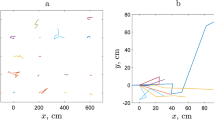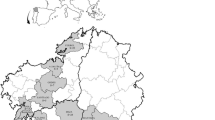Abstract
The dispersal characteristics of a population of 124 marked adult individuals (62 males and 62 females) of the armoured ground cricket (AGC), Acanthoplus speiseri Brancsik (Orthoptera: Tettigoniidae, Hetrodinae), released at the centre of a circular study site, were investigated using the capture-mark-release-recapture method for five successive days. The 110 m-diameter study site comprised five grass-trap annuli (each 1 m wide) spaced at 10-m intervals from the centre.
The frequency curve of numbers derived from recapture data for day 1 departed from normal (Kurtosis = 2.7), indicating that the released AGC population was heterogeneous in its dispersing behaviour. A comparison of mean numbers of recaptures from grass-traps per quarter portion of the study site revealed no drift in the dispersal of the population (P > 0.05), though differences in the variances of the recapture frequencies indicated a tendency towards non-random movement in the AGC population.
The population covered a mean distance of 24.47 m in the first 24 h following release and the rate of dispersal changed daily in the five-day study. The implications of the dispersal characteristics observed in this study to future design of control strategies for the pest in Zambia are discussed.
Résumé
Les caractéristiques de dispersion d’une population de 124 individus adultes (62 mâles et 62 femelles) du criquet-de-sol à armure (AGC) Acanthoplus speiseri Brancsik (Orthoptera: T ettigoniidae, Hetrodinae), relâchés au centre d’un espace d’étude circulaire (diamètre 110 m), étaient examinées en utilisant la méthode de capturer-marquer-relacher-recapturer (durant cinq jours consécutifs). Cinq pièges d’herbes appellés annuli (chacun ayant 1 métré de largeur) étaient placés Tun de l’autre (10 m à part) sur une distance croissante à partir du centre de l’espace en étude. La courbe de fréquence des nombres dérivés des résultats du recapture pendant le premier jour dévia du norme (Kurtosis = 2.7). Une comparaison des moyennes des recaptures par les pièges d’herbes dans chaque quart de l’espace d’étude révéla qu’il n’y avait pas d’amassement dans la dispersion de la population. Il n’y avait pas de difference significative entre les moyennes (P > 0.05). Quoique les differences des variances entre les fréquences des recaptures révéla qu’il y avait une tendance vers le fait que le mouvement de dispersion des AGC n’était pas un hasard.
En se dispersant la population des AGC couvrit une distance moyenne de 24.47 m durant les premières 24 heures après la relâche et la vitesse de dispersion changea chaque jour durant les cinq jours d’étude. Les implications des caractéristiques de dispersion observée dans cette étude pour le project futur des stratégie de control de la peste en Zambie sont examinées.
Similar content being viewed by others
References
Dobzhansky T. and Wright S. (1943) Genetics of natural populations: X. Dispersion rates in Drosophila pseudoobscura. Genetics 28, 304–340.
Fletcher B. S. (1974) The ecology of a natural population of Queensland fruit fly, Dacus tryoni V. The dispersal of adults. Aust. J. Zool. 22, 189–202.
Mbata K. J. (1991a) Plant associations and rates of population interchange between two food plant areas of Acanthoplus speiseri Brancsik (Orthoptera:Tettigoniidae, Hetrodinae). Insect Sei. Applic. 12, 401–408.
Mbata K. J. (1991b) Food plant pbl]References and spatial dispersion patterns of the armoured ground cricket, Acanthoplus speiseri Brancsik (Orthoptera: Tettigoniidae, Hetrodinae). Insect Sei. Applic. 12, 635–639.
Mbata K. J. (1992a) Field identification of the immature stages of Acanthoplus speiseri Brancsik (Orthoptera: Tettigoniidae, Hetrodinae), a pest of grain crops in Zambia. J. ent. Soc. Sth. Afr. 55, 213–225.
Mbata K. J. (1992b) Functional morphology of the stridulatory apparatus of Acanthoplus speiseri Brancsik (OrthopteraTettigoniidae: Hetrodinae). J. ent. Soc. sth. Afr. 55, 227–244.
Mbata K. J. (1992c) Some observations on the reproductive behaviour of Acanthoplus speiseri Brancsik (OrthopteraTettigoniidae, Hetrodinae) Insect Sei. Applic. 13, 19–26.
Musonda E. M. (1990) Biology and control of the armoured cricket (Acanthoplus speiseri). Productive farming. Off. J. Zambia Commer. Farmers Bur. 195, 27–29.
Richards O. W. and Waloff N. (1954) Studies on the biology and population dynamics of British grasshoppers. Anti-Locust Bull. 17, 182.
Scholtz C. H. and Holm E. (1989) Insects of Southern Africa. Butterworths, Durban, South Africa.
Skaife S. H. (1979) African Insect Life. 2nd Edn. Longmans Green & Co., London. 387 pp.
Southwood T. R. E. (1978) Ecological Methods. Chapman & Hall, London. 524 pp.
Author information
Authors and Affiliations
Corresponding author
Rights and permissions
About this article
Cite this article
Mbata, K.J. Dispersal Characteristics of the Armoured Ground Cricket, Acanthoplus speiseri Brancsik, a Pest of Grain Crops in Zambia. Int J Trop Insect Sci 18, 189–195 (1998). https://doi.org/10.1017/S1742758400023390
Accepted:
Published:
Issue Date:
DOI: https://doi.org/10.1017/S1742758400023390
Key Words
- Acanthoplus speiseri Brancsik
- armoured ground cricket
- dispersal characteristics
- Hetrodinae
- Orthoptera
- Tettigoniidae




